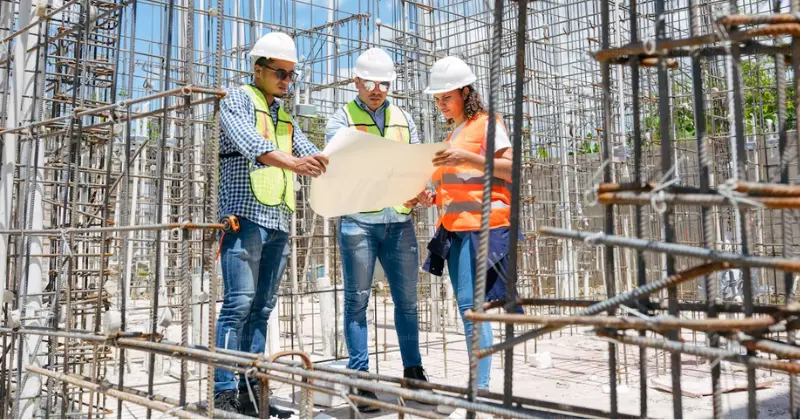
Construction Collaboration Software
Construction collaboration software improves cooperation and document management by connecting all project stakeholders into a single platform for easy information exchange. With tools for uploading, organizing, and accessing files in real-time, teams can avoid data silos and outdated information, reducing the risk of miscommunication. Version control is often included in construction collaboration software, ensuring everyone works with the most recent documentation, drawings, and specifications. These solutions simplify processes, increase productivity, and assist teams in delivering projects with more accuracy and efficiency by centralizing communication and document access.

Explore RIB’s Construction Project Collaboration Software
RIB’s construction collaboration software strengthens document management and collaboration by facilitating the exchange of information between site and office teams, avoiding reworks and contributing to project success. Our products are built to keep projects on track and document any issues that affect timing, budget, or safety. With this approach, we help to boost accuracy, efficiency, and overall project success.
RIB CX
RIB CX is a centralized communication hub to keep your data organized, accessible, and up to date. Teams can capture and store all activity and interactions related to the project in one place for all key stakeholders.
RIB CX’s document management and collaboration software are impeccably designed. The forum-based system empowers team members to exchange information effortlessly within the platform, enhancing transparency and averting communication bottlenecks.
- Manage, mark-up and distribute documents centrally for simplicity and security.
- Real-time sync updates provide the most accurate information on-the-go.
- Set permission levels for teams so individuals only receive relevant information.

RIB Connex
RIB Connex is construction project collaboration software that is crafted to safeguard data and elevate team efficiency across the entire project lifecycle. It supports a range of BIM files, enabling your teams to coordinate, create, and share documents on a centralized platform.
RIB Connex harnesses advanced technology, including configurable construction workflows, to ensure project adherence and comprehensive documentation of issues impacting time, budget, and safety.
- Make annotations and comments in the 3D model and on 2D plans.
- Inspect the design material and coordinate faster.
- Create an RFI task from a specific object or room, add photos and documents.

RIB Project
RIB Project is secure and collaborative document management and collaboration software that facilitates a structured and organized environment for teams. Enable your teams to work through documents, submit bids, and control important construction project documentation.
Safeguarded in a NATO-certified cloud environment, RIB Project offers a significant advantage for project stakeholders to collaborate and coordinate seamlessly across various locations and devices. Ensure consistent document workflows and confidently share information across a large workforce, thereby minimizing changes and mitigating costly rework in your project.
- Automated workflows of temporary and approved documents.
- Version control, comparing files, efficient search function and integrated 2D, 3D & BIM viewer.
- Full documentation and traceability throughout the project – resolve disputes using the audit trail.

What Our Clients Say
Construction Collaboration Software FAQs
Construction collaboration software is designed to streamline communication and coordination between various construction roles. By offering a single source of truth, teams can successfully track and manage tasks to ensure the project remains on time and within budget.
Poor communication and collaboration in construction projects can lead to mistakes, legal disputes, and quality issues, significantly affecting the project’s profitability. Therefore, investing in solutions that will boost coordination, transparency, and accountability within teams is more important than ever. These tools offer powerful functionalities, including document management, scheduling, budget tracking, real-time communication, and much more, to ensure everyone works from a centralized location. This eliminates the decades-long collaboration challenge in the building industry and opens doors to more efficient and successful projects.
With poor project data and miscommunication being two of the top contributors to rework, it is impossible to ignore the importance of collaboration and effective document management in construction projects. Thanks to a digital environment, teams no longer need to share static documents that get lost in infinite email threads or, even worse, in a stack of paper. All project information can be updated and shared in real-time, ensuring everyone is working with the latest data available. Other benefits of modern construction project management collaboration software include:
Better communication: These solutions improve communication in construction projects by centralizing all documentation, including drawings, reports, specifications, contracts, change orders, and much more, in a single place. This ensures a higher level of collaboration, accountability, and transparency.
Increased productivity: Paired with centralized access to project information, these solutions also help automate several tasks, reducing the risk of error and freeing time to focus on other higher-value activities, leading to increased construction productivity.
Higher quality of work: By allowing the different teams to communicate and collaborate, errors significantly decrease, resulting in a high-quality result. This also translates into higher levels of client satisfaction and a boost in the contractor’s reputation.
More accurate budgets and schedules: By having access to all project information in a single location, budgets, and schedules can be planned with the full picture in mind, ensuring activities don’t overlap and that every little detail is accounted for. This also helps reduce errors and meet the project’s quality, time, and budgetary requirements.
Improved standardization: These solutions boost collaboration and ensure everyone works based on the same guidelines, goals, and information. This level of standardization ensures no mistakes are made during the different construction project phases.
Enhanced risk management: With higher visibility into all aspects of the project, risks can be identified early, allowing for the implementation of smart mitigation strategies that avoid costly repairs in the future.
Construction project collaboration software is essential to connect the different disciplines and increase the efficiency and productivity of the project. Some key functionalities these solutions should offer include:
Document management: This feature should enable users to eliminate paper and manage all project documentation in a centralized online environment. That way, all crucial project information can be accessed in one place, ensuring everyone works from a single source of truth.
Real-time collaboration: As a part of the document management functionalities, the best software for construction collaboration should allow teams to work simultaneously on the same document, leave comments, and more. This allows them to collaborate simultaneously and see the latest updates to prevent errors or miscommunications.
BIM support: Collaboration is at the center of BIM technology. Therefore, professional software should support a range of BIM files fully integrated with schedules and budgets for enhanced efficiency.
Project management: For a collaborative environment to succeed, the software you decide to invest in should offer robust project management features. These features should help you get a 360-degree view of the project and generate budgets, schedules, contracts, and more, with a full picture in hand and clear roles and responsibilities to ensure success.
Audit trail: Transparency and accountability are two huge aspects of successful collaboration. Knowing who oversees what facilitates conversations and issue management. That is why the best tool should leave an audit trail to see the changes made to a document, who made them, and when.
Mobile accessibility: This feature should enable teams to access relevant documentation and other project information directly from their mobile devices. It should also allow teams to capture, assign, and track issues in real-time for increased efficiency.
Reporting: Tracking the impact of different activities and processes is key to project success. Real-time reports promote collaboration by keeping everyone updated about the latest developments in the project. Modern software should offer interactive and customizable reports to support strategic decision-making.
In the past, teams that worked on the site had to wait to get to the office to put together a document and share all their findings, progress, and potential issues. This made fixing issues or tracking progress against goals extremely slow and subject to errors due to details being left out or the right people not getting the information. This is one of the biggest challenges modern construction collaboration software helps to eliminate.
These solutions work on the cloud, allowing site teams to share images, comments, and other relevant information about the progress of the different activities in real-time directly from their mobile devices. For instance, a construction manager might find a quality issue and share images that can be sent directly to the person in charge of that task, ensuring it can be handled immediately. Likewise, this information can be accessed to the people in the office who can assess the impact of the issue on the project’s timeline and budget, allowing for agile decision-making and effective issue resolution.
Document management solutions are at the core of successful collaboration. Construction projects comprise a mix of people, processes, tools, and, most importantly, information, including contracts, drawings, specifications, reports, timelines, budgets, and much more. This information must be conveyed successfully to ensure all the other pieces work as expected. As straightforward as that sounds, collaboration has been challenging for decades in the building industry, mostly due to version control issues, missing information, disconnected teams, and much more.
Luckily, this is not the case anymore, as modern construction document management software provides the perfect digital environment for companies to manage their information in a centralized location, where they can easily access and share relevant documentation that is up to date. This significantly boosts collaboration by ensuring everyone works from a single source of truth and by eliminating the issues of multiple outdated documents that lead to rework.










